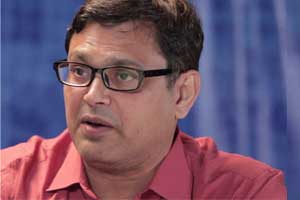- Home
- Editorial
- News
- Practice Guidelines
- Anesthesiology Guidelines
- Cancer Guidelines
- Cardiac Sciences Guidelines
- Critical Care Guidelines
- Dentistry Guidelines
- Dermatology Guidelines
- Diabetes and Endo Guidelines
- Diagnostics Guidelines
- ENT Guidelines
- Featured Practice Guidelines
- Gastroenterology Guidelines
- Geriatrics Guidelines
- Medicine Guidelines
- Nephrology Guidelines
- Neurosciences Guidelines
- Obs and Gynae Guidelines
- Ophthalmology Guidelines
- Orthopaedics Guidelines
- Paediatrics Guidelines
- Psychiatry Guidelines
- Pulmonology Guidelines
- Radiology Guidelines
- Surgery Guidelines
- Urology Guidelines
ABSORABLE STENTS - A failure of concept or technology??

The bioresorbable scaffold was introduced as a fourth revolution in the stent technology which has currently fallen into disrepute because of a very high incidence of scaffold thrombosis and post-procedure myocardial infarction.
Dr.Sundeep Mishra, the senior cardiologist at AIIMS recently reviewed this issue of the failure and the future expectations.While the stent proposed by Abbott ABSORB STENT has been withdrawn from the market, still the industry and the profession has got firm believe with the concept that the metallic prosthesis should not be left in the body after when it is not required.
In a review article published in Indian Heart Journal, Dr.Sundeep Mishra, also talks about what are the reasons of the failure and what lies in the future.According to the author, the reasons for this negative evolution could be numerous and encompass histopathological, mechanical and behavioral explanations.
He also talks about what are the reasons of the failure and what lies in the future.
Histopathological co-relates
- Dense distribution of incompletely embedded, thick protruding struts (which are incompletely endothelialized) may disrupt the laminar flow and induce endothelial shear stress, a precursor for adherent thrombosis.
- Early structural disruption and late scaffold discontinuity, as apart of property of polymer used, with elongation and break at resorption points- an inherent component of resorption process(which in any case appears delayed in humans) could also make the site vulnerable to thrombotic events for a prolonged period of time.
- Peri-strut, low-intensity area (PSLA) in absence of classical mechanical triggers has been correlated with peristrut inflammation, mal-apposition, evagination, strut fracture, and un-endothelized struts in metallic DES and could serve as additional patho-physiological correlates with BRS as well.
Mechanical factors
The mechanical limitations of current BVS are:
- Low tensile and radial strength of scaffold material. Typically Bioresorbable polymers, polylactide (PLLA) and poly(d,l-lactide)have tensile strengths ranging between 45 and 70 MPa(<200 times) compared with nearly 1500 MPa with cobalt chromium. The radial strength is also around 10 times lower.1,8,9Thus to improve the tensile and radial strengths, typically greater strut thickness (150 m) may be required but this modification may still remain inadequate to overcome the vast differences in radials and tensile strengths. Consequently, the embedding force during the deployment of scaffold may still remain deficient resulting in only partly embedded and largely exposed scaffold struts (a focal point for thrombus formation),despite high-pressure post-dilatation.
- Insufficient ductility is another mechanical aspect which affect not only the crimping ability of scaffold on the delivery balloon but also limits the range of device expansion because thepolymer may easily snap during the process of deployment. Thebreak-point for polymers occurs at only 2% to 6% of elongation compared with 40% for metallic stents.10,11
- Improper design of scaffold could be another factor. The rectangular shape and excessive height compared with current generation DES, increases its foot-print within the lumen, a largepart protruding from the vessel wall, contributing to blood flow disturbances with consequent at least two-fold risk of scaffoldthrombosis.12
- Strut thickness has been a correlate of metallic stent thrombosis and re-stenosis. However, this factor seems to play a lesser important role in context of BRS.
Physician factors
Several research and operator factors are also responsible for the current scenario.
- Research questions may not have been properly framed and device trials pushed through without properly understanding how to use the device.
- Inappropriate procedural technique; improper choice of lesions(small vessel, diffuse disease, calcific lesions), inability to prepare proper bed, sub-optimal vessel sizing and inability to achieve optimal deployment (non use of imaging techniques like OCT and IVUS, malapposed struts and inadequate post dilation- with balloon sized ≥1.1:1 compared with scaffold diameter) all contribute to scaffold thrombosis.
- Dual anti-platelet therapy discontinuation by physician or patients themselves also remains a risk factor for scaffold thrombosis.
According to author, there is a need for innovations in material science to overcome the deficiencies in future. The innovations can be attempted by improving complex composition and strength of polymers and using newer polymers with a focus to try achieve a lower strut thickness, which was a correlate of DES outcomes.But this alone may not yield favorable results as BRS the most important predictor of thrombosis is a low tensile and radial strength contributing to unembedded scaffold struts, a precursor for future events. Thus lower strut thickness could actually lead to even lower tensile/radial strength, and thus even less properly embedded scaffold struts, potential recipe for paradoxically increased scaffold thrombosis.The need of hour is a landmark innovation in polymer technology and there is still the lot of work to be done in this direction.
To Read the full editorial click on the following link: https://doi.org/10.1016/j.ihj.2017.10.004

Disclaimer: This site is primarily intended for healthcare professionals. Any content/information on this website does not replace the advice of medical and/or health professionals and should not be construed as medical/diagnostic advice/endorsement or prescription. Use of this site is subject to our terms of use, privacy policy, advertisement policy. © 2020 Minerva Medical Treatment Pvt Ltd